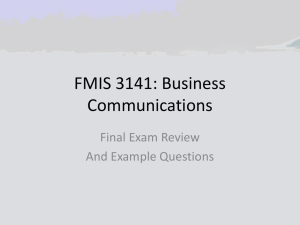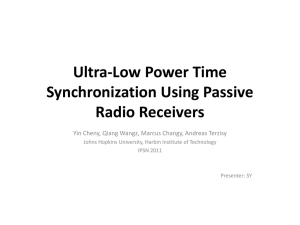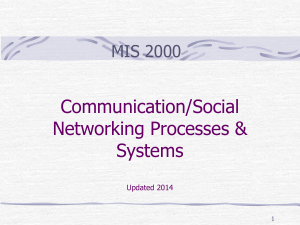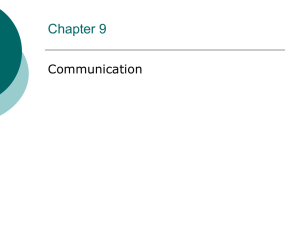Global Positioning System Receiver and Inter
advertisement
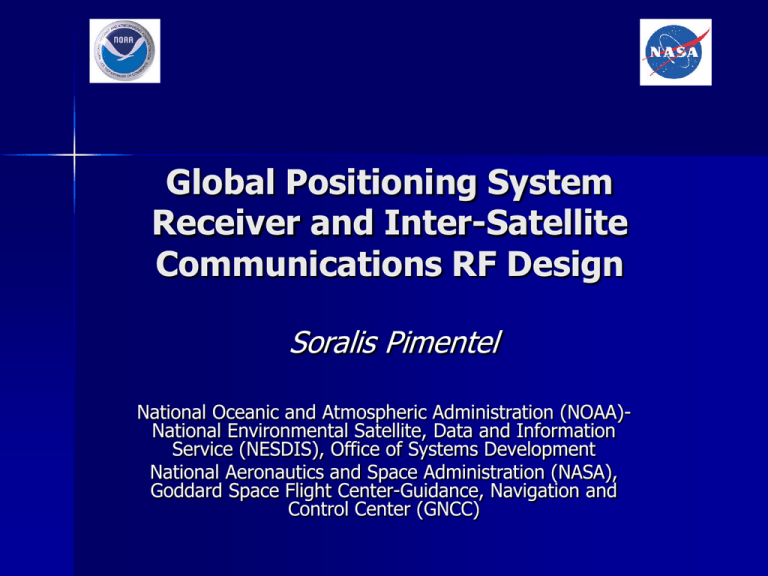
Global Positioning System Receiver and Inter-Satellite Communications RF Design Soralis Pimentel National Oceanic and Atmospheric Administration (NOAA)National Environmental Satellite, Data and Information Service (NESDIS), Office of Systems Development National Aeronautics and Space Administration (NASA), Goddard Space Flight Center-Guidance, Navigation and Control Center (GNCC) Project NOAA NESDIS NASA Goddard Space Flight Center, GNCC Magnetospheric Multi Scale (MMS) GOES-R Series Mission GPS Applications RF down conversion receiver GPS weak signal receiver Inter-satellite Ranging and Alarm System (IRAS) RF up conversion and modulation transmitter RF down conversion receiver GOES Mission • This constellation provide information about meteorological events in the Western atmosphere • GOES-R measurements will result in more accurate weather forecasts, atmosphere, climate, and ocean monitoring. Global Positioning System (GPS) Satellite radio navigation system Passive system that uses trilateration positioning method Array of satellites to measure position, velocity and time Positioned on the middle earth orbit (MEO) Designed to measure on the lower earth orbit (LEO) down to earth’s surface GOES-R GPS application could be used to validate measurements GEO GPS orbits -130dBm 42.6 degrees (L1) LEO (below 3000 km) -145dBm HEO spacecraft First side lobe Main lobe Objectives To design, build and test Radio Frequency (RF) chains – Magnetospheric Multi Scale (MMS) mission, IRAS: Global Positioning System: Down-conversion frequency receiver and power amplification Up-conversion and phase modulator transmitter Weak signal down-conversion frequency receiver and power amplification For future GOES-R applications and others Design Requirements GPS receiver: Input of -111dBm at 1.57542 GHz for an output of +4dBm at 35.42MHz IRAS communications system: – Transmitter: pulse train from a Digital to Analog Converter (DAC) of 2V peak-to-peak of +10dBm input – Receiver: input of -111dBm at 2.05 GHz for an output of +4dBm at 35.42MHz Power representation dB 10 log(P) P dBm 10 log 1m W Methodology Understanding of Electrical Engineering design skills Study information about RF design Know the requirements and specifications for the design Build and test the systems Data analyses about overall effectiveness of the chain GPS Receiver LO=1.54GHz -111dBm @1.57542GHz +20dBm +20dBm +20dBm +24.6dBm -2dBm Loss ? BPF +3.3dBm @35.42MHz Power Amplifier BPF LNA’s Loss ? -2dBm -8.5dBm LPF -3dBm -2dBm Attenuator -3dBm +24.6dBm +24.6dBm +24.6dBm Receiver output IRAS transmitter LO=2.05GHz LPF +1V BPF -2dBm -2dBm +2.2dBm @2.05GHz -1V +10dBm @1MHz -2dBm Cut-off Frequency: 2MHz -4dBm +20dBm Loss ? Center frequency: 2.05GHz B=10MHz Low Pass Filter Design Cut-off frequency= 2MHz @ -1dB, Pass Band Frequency=1.9MHz, Pass Band Ripple= 0.5dB IRAS Receiver LO=2.01458GHz BPF -111dBm @2.05GHz +21dBm Center frequency=2.05GHz LNA’s +21dBm -3dBm Loss ? -8.5dBm BPF Power Amplifier +20dBm -2dBm Attenuator Center frequency=35.42MHz +4dBm @35.42MHz LPF -3dBm +24.6dBm Loss ? +24.6dBm +24.6dBm +24.6dBm Acquired Knowledge • • • • • Hands-on Engineering design System requirements and specifications RF principles and applications Filter design and implementation Overall system effectiveness analyses References Mistra, Pratap; Enge, Per. Global Positioning System, Signal, Measurements, and Performance Ganga-Jamuna Press, Massachusetts, 2004 McClaning, Kevin; Vito, Tom. Radio Receiver Design. Noble Publishing Corporation, Atlanta, GA, 2000 www.minicuircits.com Jeyasunder, David. Magnetospheric Multi-Scale Mission Observatory/Spacecraft Requirements Document. Code 461 Goddard Space Flight Center, 2005 Bowick, Chris. RF Circuit Design. Newnes Indianapolis, 1982 Filter Free design software NESDIS Office of Systems Development, GOES-R. http://www.osd.noaa.gov/goes_R/ Acknowledgments NOAA-EPP program, for the opportunity of this internship and the Kennedy Space Center trip ORISE Edward Miller, NESDIS-Office of System Development, for mentoring Greg Boegner, Miriam Wennersten, NASAGoddard Space Flight Center, GNCC for the opportunity of interrelating a project between NOAA and NASA NWS Aviation Services Branch Plans for next summer Find a project that includes both Engineering and Atmospheric Science in order to integrate an interdisciplinary background for Graduate studies consideration. Questions? Backup Slides Spacecraft Electrical Power Subsystem (PSE) Control and Data Handling Guidance and Navigation Center Solar Array Spacecraft computer Position Plasma instruments Instruments Batteries Telemetry Time Energetic particle detectors Power Distribution Memory Range Electric field instruments Interface Velocity Magnetometers Inter Satellite Ranging and Alarm System (IRAS) IRAS is part of MMS Ranging: – It is used to measure the relative distances among four satellites forming a tetrahedron Alarm: – Passing packets of orbit data – Pass alarm messages between the observatories Electrical Engineering Facts Transmitter: – Source of data information and process the signal for transmission to another medium Receiver: – Receives a signal from an external source to process the information Amplifier: – Integrated circuit that increases the power, voltage or current of a signal Mixer: – Mixes the RF signal with the local oscillator signal to obtain the IF output. Electrical Engineering Facts Filter: sort out unwanted frequency ranges – Low Pass (LPF), High Pass (HPF), Band Pass (BPF), Band Reject (BRF) Modulation: alter a signal inserting a carrier – Phase Modulation (PM) Encoding of information into a carrier wave by variation of its phase in accordance with an input signal Power representation in decibels, dB or dBm dB 10 log(P ) dBm 10 log P 1m W Materials Amplifiers Band Pass filters, Low Pass filters Mixer Power amplifiers Attenuators Coaxial cables Spectrum analyzer Power supply and signal generator

